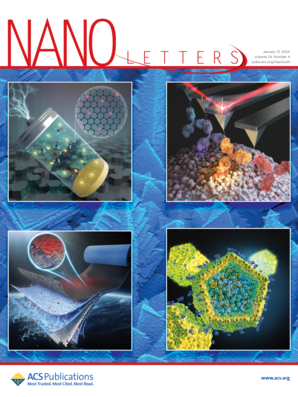用于反铁电材料电特性分析的独创 "正-上-负-下 "协议
IF 9.6
1区 材料科学
Q1 CHEMISTRY, MULTIDISCIPLINARY
引用次数: 0
摘要
本文介绍了AFE-PUND测量方法,这是一种原始的正向上负向下(PUND)协议,旨在准确研究反铁电(AFE)薄膜的行为。对于等效的FE方法,afe - bund方法将开关电流从非开关贡献中分离出来,从而能够从磁滞回线曲线中精确提取饱和极化和矫顽力场。本文将AFE- bund部署在不同厚度的AFE ZrO2薄膜上。结果表明,饱和极化随薄膜厚度的增加而增加,表明区域稳定性增强,而在较厚的薄膜中,耐力循环表现出唤醒效应及其最终的疲劳退化。同样,矫顽力场也随着厚度的增加而减小,这反映了转换势垒的减少以及四方相和正交相之间更明显的转变。AFE- pund是一种非常有价值的方法,可以促进对AFE材料的理解和优化。本文章由计算机程序翻译,如有差异,请以英文原文为准。

An Original Positive-Up-Negative-Down Protocol for Electrical Characterization of Antiferroelectric Materials
This work introduces the AFE-PUND measurement method, an original positive up negative down (PUND) protocol intended to accurately study antiferroelectric (AFE) thin-film behavior. As for its FE counterpart, the AFE-PUND method isolates switching currents from nonswitching contributions, enabling a precise extraction of saturation polarization and coercive fields from hysteresis loop curves. In this paper, AFE-PUND was deployed on AFE ZrO2 films of varying thicknesses. The results reveal that saturation polarization increases with film thickness, indicating enhanced domain stability, while endurance cycles showcase the wake-up effect and its eventual fatigue-induced degradation in thicker films. Similarly, coercive fields decrease with thickness, reflecting reduced switching barriers and a sharper transition between the tetragonal and orthorhombic phases. AFE-PUND establishes itself as an extremely valuable method for advancing the understanding and optimization of AFE materials.
求助全文
通过发布文献求助,成功后即可免费获取论文全文。
去求助
来源期刊

Nano Letters
工程技术-材料科学:综合
CiteScore
16.80
自引率
2.80%
发文量
1182
审稿时长
1.4 months
期刊介绍:
Nano Letters serves as a dynamic platform for promptly disseminating original results in fundamental, applied, and emerging research across all facets of nanoscience and nanotechnology. A pivotal criterion for inclusion within Nano Letters is the convergence of at least two different areas or disciplines, ensuring a rich interdisciplinary scope. The journal is dedicated to fostering exploration in diverse areas, including:
- Experimental and theoretical findings on physical, chemical, and biological phenomena at the nanoscale
- Synthesis, characterization, and processing of organic, inorganic, polymer, and hybrid nanomaterials through physical, chemical, and biological methodologies
- Modeling and simulation of synthetic, assembly, and interaction processes
- Realization of integrated nanostructures and nano-engineered devices exhibiting advanced performance
- Applications of nanoscale materials in living and environmental systems
Nano Letters is committed to advancing and showcasing groundbreaking research that intersects various domains, fostering innovation and collaboration in the ever-evolving field of nanoscience and nanotechnology.
 求助内容:
求助内容: 应助结果提醒方式:
应助结果提醒方式:


